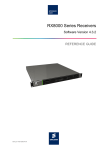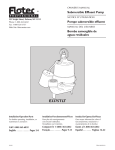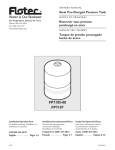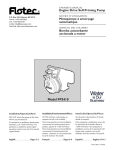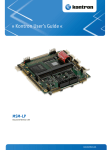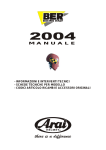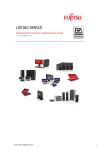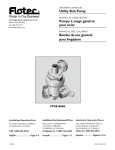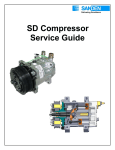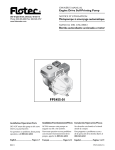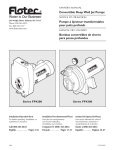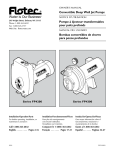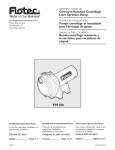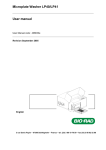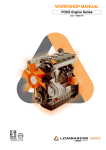Download Service Manual RW Series
Transcript
FLOTEC INC 7625 West New York Street Indianapolis, IN 46214-4911 317-273-6960 (Fax) 317-273-6979 e-mail: [email protected] web site: http://www.floteco2.com Service Manual RW Series M-Service Manual RW Series Regulator(2014-07-31.docx.pdf -1- TABLE OF CONTENTS I. TOOLS, TEST EQUIPMENT AND SERVICE MATERIAL A. TOOLS B. TEST EQUIPMENT C. SERVICE MATERIALS II. SPECIFICATIONS III. THEORY OF OPERATION IV. DEFINITION OF STATEMENTS V. PRODUCT CLASSIFICATION DATABASE VI. INSTALLATION INSTRUCTIONS VII. SERVICE AND REPAIR A. CLEANING, LUBRICATION AND SEALING 1. INLET CONNECTIONS a. REMOVABLE CGA OR INTERNATIONAL CONNECTION b. INSTALLATION CGA OR INTERNATIONAL CONNECTION 2. DISS AUXILIARY OUTLETS a. REMOVAL b. SERVICE c. INSTALLATION 3. CONTENTS GAUGE a. REMOVAL b. INSTALLATION 4. FLOWMETER a. REMOVAL b. SERVICE c. INSTALLATION 5. REGULATOR INTERNAL COMPONENTS a. REMOVAL b. SERVICE c. INSTALLATION VIII. A. B. C. D. E. TESTING CONTENTS GAUGE TEST LEAK TEST STATIC PRESSURE TEST DYNAMIC PRESSURE TEST FLOWRATE TEST IX. REPLACEMENT PARTS LIST FOR RR8xxx-xxxxxx AND RR5xxx-xxxxxx X. TROUBLESHOOTING GUIDE XI. DRAWINGS: a. b. c. RXAXX-XXXXX RXCXX-XXXXX RXDXX-XXXXX YOKE CGA 500 RW REGULATOR W/NUT AND NIPPLE CGA 320 RW REGULATOR WITH NUT AND NIPPLE CGA 880, CGA 930, CGA 960, CGA 965 RW REGULATOR -2- d. e. f. g. RXEXX-XXXXX RXGXX-XXXXX RXNXX-XXXXX RXRXX-XXXXX KNURLED NUT h. RXSXX-XXXXX STEEL NIPPLE ASSY i. RX1XX-XXXXX j. RX5XX-XXXXX k. RX7XX-XXXXX l. RX8XX-XXXXX m. RX8XX-S-XXXXX n. XXXXX o. TEST PROJECT p. MODULATED FLOW q. RW REG. PARTS r. RW REG. PARTS I. BS 341 #3 REGULATOR WITH NUT AND NIPPLE DIN 477-9 RW REGULATOR WITH NUT AND NIPPLE CGA 660 NITRIC OXIDE REGULATOR CGA 626 REGULATOR W/ CHROME PLATED CGA 626 REGULATOR W/ BRASS NUT, STAINLESS CGA 580 REGULATOR WITH NUT AND NIPPLE CGA 540 REGULATOR WITH NUT AND NIPPLE CGA 940 AND CGA 973 RW REGULATOR YOKE ASSY CGA 870 YOKE UNIBODY OXYGEN REGULATOR RW REGULATOR W/ OXYSAVRR FLOWMETER SUB-ASSEMBLY STATIC AND DYNAMIC TEST PROCEDURE (MANIFOLD IS CLOSED AND OPENED) CGA 870 COMPONENT PART NUMBERS CGA 540 COMPONENT PART NUMBERS TOOLS, TEST EQUIPMENT AND SERVICE MATERIAL A. TOOLS Screwdriver - 1/4 in. (6 mm) flat blade Screwdriver-No.2 Phillips Open end wrenches – 7/16 in, 9/16 in, 5/8 in, 11/16 in Adjustable wrench-10 in (25 cm) Hex key wrench-1/16 in Internal retaining ring pliers Punch-1/8 in (3 mm) Hammer C-Clamp-3 in (8 cm) Dental Pick (or similar pointed instrument) B. TEST EQUIPMENT Test flowmeter with an accuracy of + or – 2% if reading @ 70 degrees F (21 degrees C) and 14.7 PSI (101 kPa) Test pressure gauge with a range of 0-100 psi (0-690 kPa) and accuracy in according to ASME 40.1-1998, Grade “B”, permissible error (+/- % of span): - lower ¼ of scale (0-25 psig) = +/- 3%; - middle ½ of scale (25-75 psig) = +/- 2%; - upper ¼ of scale (75-100 psig) = +/- 3%. Boom-Box Leak detector – Nupro “Snoop” or equivalent (oxygen compatible) C. SERVICE MATERIALS DuPont Krytox performance lubricants GPL206 Teflon tape – ¼ in (6 mm) -3- Isopropyl alcohol Cloth – lint free Oxygen tubing – ¼ in (6 mm) I.D. Screw – 6-32 UNC Service Instructions Work Instruction WI-PRO-010 “General Assembly Procedures for RW and FM (Exhibit “A”)” II. SPECIFICATIONS Flotec Medical Gas Regulators are small, lightweight devices that are available in a variety of configurations to meet the various requirements for medical gas delivery. Flotec Medical Gas Regulators can be equipped with a 12 position, detented flow control valve or a variety of designated inlet flow connectors. Units are also available with single or dual high flow DISS outlets. Both small cylinder and large cylinder inlet connections are available on all regulators. The following instructions provide information to assist qualified personnel in the service and repair of Flotec Medical Gas Regulators. It is recommended that the repair technician read these service and repair instructions thoroughly before servicing Flotec Regulators. Storage Temperature: -30 degrees F to 140 degrees F Operating Temperature: -20 degrees F to 150 degrees F Materials: Brass, Bronze, Anodized Aluminum, Stainless Steel, Teflon, Neoprene, Silicone, Viton, EPDM Filtration: 20 micron Supply Pressure Range: 250 to 3000 PSI Operating Pressure: 50 PSI (17, 20, 24, 30, 40, 58, 70, 90, 110 PSI available upon request) Relief Valve Pressure: 75 PSI or 95 PSI Inlet Connections: Any CGA inlet connection is available for specific gases and most International is available upon request Dimensions: Variable depending on type and style specified Weight: Variable depending on type and style specified Indicators: Cylinder Contents, Medical Gas Flow Rate Power take off Outlet Connections: none, 1 or 2 of any combination of the following: DISS check valve, Chemetron QD, Hansen QD, Ohio QD, Puritan Bennett QD, Schrader QD, plugged 1/8” FNPT ports, or plugged ¼” FNPT ports. Flowmeter Outlet Connection: DISS fitting or Hose Barb III. THEORY OF OPERATION The Flotec Medical Gas Regulator is a single stage piston-type regulator. When it is initially attached to a high-pressure gas cylinder, the internal components are in the position shown in enclosed drawings. With the cylinder off, the spring exerts force against the piston assembly and pushes the piston assembly away from the regulator seat. When the cylinder valve is opened, high-pressure medical gas (approximately 2000 PSI oxygen for a full cylinder) passes through the inlet filter and flows through the seat. The gas then flows through the shaft of the piston and exits to the regulated output cavity. The gas continues to flow into this area until the cavity builds enough pressure to overcome the force of the spring, which occurs at 50 PSI. The piston assembly then moves toward the seat and the seal blocks the flow path and prevents the pressure from rising above 50 PSI. This all occurs in a fraction of a second. When gas is let out of the output cavity through the flow-controlling device, the pressure in the cavity drops. The spring then pushes the piston assembly away from the seat to allow the oxygen to restore the pressure to 50 PSI and deliver -4- the flow through the flow-controlling device at the prescribed rate. This too happens in a fraction of a second. In the unlikely event that the regulator does not regulate properly and should the internal pressure rise above 75 PSI or 95 PSI, the relief valve will unseat and safely release gas through the vent holes in the side of the body. NOTE The Flotec Medical Gas adjustable flow regulator is shown in enclosed drawings. The internal regulator components are common to all Flotec Oxygen Regulators and Pressure Reducers. IV. DEFINITION OF STATEMENTS Statements in this manual proceeded by the following words are of special significance. WARNING means there is the possibility of injury or death to you or others. CAUTION means there is the possibility of damage to the unit or other property. NOTE indicates points of particular interest for more efficient and convenient operation. Always disassemble, inspect, clean and repair regulator components in accordance with these instructions. Be aware of all the potential hazards associated with handling and using highpressure gas equipment. Also, be aware that the possibility of fire exists when the combination of a combustible material, a source of ignition and oxygen is present (called the Fire Triangle. WARNING Replacement of parts on high-pressure regulators should be made only by qualified personnel familiar with their operation. Do no remove or install parts with the regulator installed on a cylinder. Use only the proper repair tools and parts. Always wear eye protection when servicing high-pressure regulators. WARNING Contaminants or hydrocarbons in the presence of an ignition source and oxygen may combine and burn violently. Never permit oil, grease or other combustible substances to come in contact with oxygen cylinders, regulator parts or repair tools. Provide a clean, oil free surface on which to place disassembled regulator parts. WARNING Always open high-pressure oxygen cylinder valves SLOWLY. This should always be done in order to allow the heat of gas compression to dissipate. Always verify that the oxygen cylinder valve is fully closed (clockwise) before disconnecting the regulator from the cylinder. WARNING Do not obstruct the vent holes in the body of the regulator. These holes must be open to atmosphere for proper regulator operation. WARNING Flotec Regulators with yoke are equipped with a rubber and metal inlet seal washer. Never use a non-Flotec inlet seal washer. Always use only one inlet seal washer and only this style of washer when attaching the regulator to a cylinder. V. PRODUCT CLASSIFICATION DATABASE Device Regulator, Pressure, Gas Cylinder Device Description Pressure regulator Medical Specialty Anesthesiology -5- Product Code Regulation Number Device Class GMP Exempt? 510(k) Exempt? CAN FDA #868.2700 1 No Yes European Commission Meddev 2.4/1 Rev 8 Part 2 Rule 11 – Active devices to administer, remove medicines and other substances to or from body, or Directive 93/42/EEC – Class 2B – Pressure regulator for medical gases. Health Canada CAN/CSA-Z305 87M- Medical Devices Regulations Classification Rules for Medical devices, Part 1, Rule 9- Active devices to administer or withdraw energy to or from the body- Class 2 – Medical Pressure regulator. VI. INSTALLATION INSTRUCTIONS See Instructions for use provided with each regulator; See Work Instruction WI-PRO-010 “General Assembly Procedures for RW and FM (Exhibit “A”)”. VII. SERVICE AND REPAIR Always perform the regulator test procedures in this manual before placing a repaired regulator back in service. Note: Refer to the Parts List and Parts Illustration for identification of parts referenced with bold numbers. A. CLEANING, LUBRICATION AND SEALING Clean the metal parts of the regulator with isopropyl alcohol. Use a mild solution of soap and water to clean the plastic parts. Use a clean lint free cloth with isopropyl alcohol to clean the internal parts, being certain to remove any residual fibers. O-ring seals that have been cleaned or are new replacements should be lubricated with a film of DuPont Krytox performance lubricants GPL206. Whenever pipe threaded (NPT) connections must be disassembled, reseal the threads with Teflon tape. When applying teflon tape remove old sealant from the male and female threads and wrap the male threads with Teflon tape in a clockwise direction, starting 1 to 2 threads back from the end. 1. INLET CONNECTIONS a. REMOVABLE CGA OR INTERNATIONAL CONNECTION 1. 2. Using a strap wrench on the regulator body and an appropriately sized open-end wrench on the nipple, tailpiece, or yoke assembly, remove the assembly from the ¼” female NPT port. Remove old sealant from the male and female threads. CAUTION Hold the regulator with the inlet port down so that any particulate matter will fall out of the port. -6- 3. b. INSTALLATION CGA OR INTERNATIONAL CONNECTION 1. 2. c. 2. 3. 4. 5. 6. Unscrew the flow meter sub-assembly and remove the piston/manifold assembly from the base of the regulator. Also remove the CGA washer, unscrew the retainer, and remove the valveseat insert (taking care to not scratch the tip of the valve-seat insert). Take the valve-seat insert and place a small green viton o-ring (part # 2410400-001) on the side of the insert that already contains an o-ring. Put the valve-seat insert back into the hole you removed it from in the same orientation in which you found it. Also screw in the retainer and place the CGA washer back onto the retainer, making sure to tighten the retainer to somewhere between 12 and 15 ft-lb (this can be accomplished by using a model ES70T screwdriver at scale 5). Reassemble the piston/manifold assembly and screw in the flowmeter subassembly making sure to torque the flowmeter sub-assembly from 15 to 20 ft-lb. DISS AUXILIARY OUTLETS a. REMOVAL 1. 2. b. 2. c. Using a 5/8” open end wrench, remove the DISS auxiliary outlet from the regulator. Remove old sealant from the male and female threads. CAUTION Hold the regulator with the DISS auxiliary outlet ports down so that any particulate matter will fall out of the port. SERVICE 1. Disassemble the DISS auxiliary outlet by depressing the check valve plunger until the opposite end containing the o-ring clears the body. Remove the o-ring to gain access to the plunger and spring. Inspect the components for wear or damage and replace as necessary. Reassemble in reverse order. INSTALLATION 1. 2. 3. Install a replacement inlet filter in the nipple, or retainer, or yoke assembly and secure in place using a 5/16” rod and a light tap of a ball peen hammer. Reseal the male threads on the nipple, retainer, or yoke assembly with Teflon tape. Always put Teflon tape after the first full thread of the ¼” male NPT threads. Use wrenches to tighten the assembly REPAIR OF FLOTEC MEDICAL GAS REGULATORS 1. 2. If the inlet filter replacement is required, tap the old filter out of the tailpiece with a rod inserted in the threaded end of the nipple or tailpiece. Reseal the male threads on the DISS auxiliary outlet with Teflon tape. Thread the outlet into the regulator body and tighten. CONTENTS GAUGE a. REMOVAL -7- 1. 2. b. INSTALLATION 1. 2. 4. Using a 7/16" open-end wrench, remove the contents gauge from the regulator body. Remove old sealant from the male and female threads. CAUTION Hold the regulator with the contents gauge port down so that any particulate matter will fall out of the port. Reseal the male threads on the contents gauge with Teflon tape. Thread the contents gauge into the regulator body and tighten. The word “OXYGEN” on the gauge dial should be parallel to the regulator body. FLOWMETER Before attempting to disassemble the flow control valve to resolve a flow related problem, perform the following procedures for back flushing the valve to remove any debris from the valve orifices. NOTE: The flow control valve must be removed from the regulator before back flushing. a. REMOVAL 1. b. SERVICE 1. 2. 3. 4. 5. 6. c. Using a vise on the regulator body and a strap wrench on the flowmeter assembly for Yoke style regulators or two strap wrenches on Nut & Nipple style regulators turn the flowmeter counter clockwise to loosen. Backflush all 11 flow positions with a medical gas. Check the screw holding the rotor assembly onto the knob shaft for tightness. Torque rotor assembly using a model ES70T electric screwdriver, scale 9. Any other service work must be done by the manufacturer; there are no user serviceable parts in the flowmeter assembly. If the flowmeter needs to be returned to the manufacturer reassemble the flowmeter with the upper body before returning. CAUTION The flow control valve is manufactured to exacting tolerances and utilizes a number of extremely small orifices. To prevent improper valve operation due to contaminants, ensure hands, tools and worktable are clean when disassembling and servicing the flow control valve. There are no user serviceable parts in the flowmeter assembly Clean all flow control valve components with isopropyl alcohol and thoroughly blow dry. CAUTION Do not allow a lubricant film applied on the rotor face to accumulate in the rotor orifices. WARNING Do not interchange rotors and flow control valve bodies. Always assemble rotor with its original flow control valve body. Verify that the valve shaft rotates smoothly and stops at each detented position. INSTALLATION 1. 2. Replace the o-ring on the flowmeter assembly as needed. Thread the flowmeter into the upper body and turn clockwise to tighten. Using a vise on the regulator body and a strap wrench on the flowmeter -8- assembly for Yoke style regulators or two strap wrenches on Nut & Nipple style regulators turn the flowmeter clockwise to tighten to 10-15 ft-lbs. 5. REGULATOR INTERNAL COMPONENTS a. REMOVAL 1. 2. b. SERVICE 1. 2. 3. c. Remove the large o-ring from the piston for inspection. Clean the piston with isopropyl alcohol and thoroughly blow dry. Inspect both O-rings for wear or damage. Replace as necessary with new O-rings that have been lubricated with a film of Dupont Krytox performance lubricants GPL206. Inspect the seal on the end of the piston for cuts or abrasions. WARNING Failure to install the piston seal will render the regulator inoperative and will result in uncontrolled high flows through the relief valve vent ports. Clean the relief valve with isopropyl alcohol and thoroughly blow dry. Inspect the relief valve o-ring for cuts and wear. Replace the o-ring if it is damaged. Clean the inside of the regulator body with isopropyl alcohol and a lint free cloth and thoroughly blow dry. Inspect the seat for damage. Apply a film of Dupont Krytox performance lubricants GPL206 approximately ½” wide to the inner surface of the regulator body. INSTALLATION 1. VIII. Remove either the flowmeter or the end cap by following instructions under FLOWMETER removal. NOTE: References made to the flow control valve body are also applicable to the regulator end cap. If the regulator has a removable inlet connection, remove the connection from the regulator per INLET CONNECTIONS removable CGA or international connection. Install either the flowmeter or the end cap by following instructions under FLOWMETER installation. NOTE References made to the flow control valve body are also applicable to the regulator end cap. TESTING Perform the following test procedures after servicing the regulator or to determine if a regulator problem exists. WARNING If service to the internal components of the regulator has been performed, conduct a preliminary static pressure test per the “STATIC PRESSURE TEST” instructions with a medical gas cylinder pressure of approximately 500 PSI. Conduct the preliminary static pressure test before beginning any functional testing to verify that all regulator internal components have been installed correctly. NOTE All functional testing should be performed using a full cylinder of gas at 1900 to 2100 PSI. A. CONTENTS GAUGE TEST -9- 1. 2. 3. With the regulator unpressurized, verify that the contents gauge pointer is at or below the red “REFILL” area. Connect the Medical gas regulator to a full gas cylinder and SLOWLY open the cylinder valve. Verify that the contents gauge pointer moves into the green “FULL” area. B. LEAK TEST WARNING Do not attempt to repair leaks while the regulator is pressurized. 1. 2. 3. 4. 5. Connect the regulator to an appropriate cylinder or Boom Box Post valve. On regulators equipped with a flowmeter, set the flow to the off position. Apply a compatible leak test solution to all outlets, fittings, and the junction of the contents gauge and regulator body. SLOWLY open the cylinder valve or Boom Box Post valve. Constant bubbling of the leak test solution denotes the presence of a leak. Tighten fittings as required to eliminate all external leaks. DO NOT overtighten threaded connections. Close cylinder valve and note the pressure indicated on the contents gauge. This pressure should not decay more than 100 PSI in 90 seconds or less. If the regulator decays more than 100 PSI, return to factory for repair. C. STATIC PRESSURE TEST 1. 2. 3. Connect the test pressure gauge to the flow control outlet, flowmeter outlet or designated flow connector. Turn the flow control knob or flowmeter knob (where applicable) to the largest flow setting. On emergency oxygen regulators, connect the test pressure gauge to one of the DISS auxiliary outlets. Connect the regulator to a medical gas cylinder and SLOWLY open the cylinder valve. Verify that the test gauge pointer stabilizes and becomes steady at between 45 PSI and 65 PSI. NOTE “Steady” is defined as no detectable movement of the test gauge pointer for a minimum of 15 seconds. D. DYNAMIC PRESSURE TEST 1. 2. 3. 4. Connect the test pressure gauge to one of the DISS auxiliary outlets. Connect the regulator to an oxygen cylinder and SLOWLY open the cylinder valve. Set a flow on the regulator flow control or flowmeter. On emergency regulator models, slightly depress the second auxiliary outlet check valve plunger to establish a small flow of gas from the outlet. Verify that the pressure test gauge stabilizes at 50 + or - 5 PSI. E. FLOWRATE TEST NOTE A number of variables including ambient atmospheric conditions and test instrumentation resolution and accuracy will affect the results of flowrate testing. Compensation must be made for deviation from ambient conditions of 70 degrees F and 29.3 inches HG at the location of the test. 1. 2. 3. Connect the regulator to a full gas cylinder and SLOWLY open the cylinder valve. Connect the flow control barbed outlet connector, the designated flow connector or the flowmeter outlet to the test flowmeter using a suitable length of oxygen tubing. Verify that the flows read on the test flowmeter are within + or – 10% of the flow set on the regulator. For the pediatric RW or FM flow from 0.02 LPM to 0.5 LPM the tolerance of the flow should be + or – 20%. - 10 - IX. REPLACEMENT PARTS LIST FOR RR8xxx-xxxxxx AND RR5xxx-xxxxxx DESCRIPTION FLOTEC PART # PIN, DOWEL 112-1156-008 RETAINER, ORIFICE 810-6490-002 810-6490-102 BRASS THREAD INSERT 810-6039-003 THREAD INSERT (Helicoil) 810-6428-001 FILTER, DISC (new) 810-6033-021 WASHER, CGA 810-6293-001 VALVE-SEAT INSERT (w/seals) 810-6714-011 SPRING, 22 PSI SPRING, 50 PSI SPRING, 70 PSI 810-6496-001 810-6496-022 810-6672-021 ALUMINUMPISTON SUB-ASSY (w/seals) BRASS PISTON SUB-ASSY (w/seals) 010-6206-031 010-6206-041 MANIFLOD SUB-ASSY (w/seals) 010-6207-001 HOSE BARBS TO 1/8” MNPT HB12 RESIDENT NIPPLE ADAPTER HBD2 LOW PROFILE T-HANDLE (standard) 810-6568-003 LARGE T-HANDLE 810-6634-003 VITON 80 DURO O-RING (4mm x 1mm) 241-0400-100 VITON 90 DURO O-RING (2.5mm x 1mm) 810-6737-003 SEAL, ORIFICE, PISTON 810-6236-001 NEOPRENE 70 DURO O-RING 210-6022-015 SILICONE 70 DURO O-RING 210-6028-006 SILICONE 70 DURO O-RING 210-6028-019 METRIC VITON O-RING 810-6562-V01 METRIC SILICONE O-RING 810-6562-001 WASHER, FACE SEAL 810-6495-001 NEOPRENE 70 DURO O-RING 210-6022-022 - 11 - SILICONE 70 DURO O-RING 210-6028-010 O-RING EPDM, 70 DURO 220-6036-006 O-RING EPDM, 70 DURO 220-6036-015 O-RING EPDM, 70 DURO 220-6036-019 O-RING EPDM, 70 DURO 220-6036-022 STAINLESS STEEL DETENT SPRING 151-0001-001 STAINLESS STEEL DETENT BALL 553-0001-003 DOME HANDLE DH209 CHEMETRON STYLE QD TO 1/8” MNPT QDC2-12 OHIO STYLE QD TO 1/8” MNPT QDO2-12 DISS 1040 FITTING 1/8” MNPT DF-1040 DISS 1060 FITTING 1/8” MNPT DF-1060 DISS 1120 FITTING 1/8” MNPT DF-1120 DISS 1160 FITTING 1/8” MNPT DF-1160 DISS 1180 FITTING 1/8” MNPT DF-1180 DISS 1200 FITTING 1/8” MNPT DF-1200 DISS 1220 FITTING 1/8” MNPT DF-1220 DISS 1240 FITTING 1/8” MNPT DF-1240 DISS 1040 CHECK VALVE 1/8” MNPT DCV-1040 DISS 1060 CHECK VALVE 1/8” MNPT DCV-1060 DISS 1120 CHECK VALVE 1/8” MNPT DCV-1120 DISS 1160 CHECK VALVE 1/8” MNPT DCV-1160 DISS 1180 CHECK VALVE 1/8” MNPT DCV-1180 DISS 1220 CHECK VALVE 1/8” MNPT DCV-1220 DISS 1240 CHECK VALVE 1/8” MNPT DCV-1240 GAUGE AND BOOT ASSEMBLY 010-6100-081 GAUGE AND BOOT ASSEMBLY 010-6100-330 to -333 GAUGE AND BOOT ASSEMBLY 010-6100-335 to -341 - 12 - X. TROUBLESHOOTING GUIDE CONTENTS GAUGE: SYMPTOM PROBABLE CAUSE ACTION Pointer does not move after cylinder valve is turned on Cylinder is empty Regulator inlet filter is blocked Contents gauge is damaged Replace cylinder Replace inlet filter Replace contents gauge Reading drops sharply with flow through regulator Cylinder valve “cracked” open inlet filter partially occluded Fully open cylinder valve Replace inlet filter Particulate matter in regulator Clean regulator internal components Replace piston O-rings (2) Replace piston seal Replace relief valve gasket THE REGULATOR LEAKS AT: Vent holes in body Piston O-ring leaks Piston seal leaks Relief valve gasket leaks Auxiliary DISS outlet Check valve O-ring leaks Replace check valve O-ring Adjustable flow outlet with knob in off position Flowmeter not functioning properly Return to Flotec Designated flow connector Connector not properly tightened Tighten connector O-ring leaks Replace connector O-ring Threaded (NPT) connections Loose connections Disassemble clean and reseal threads, reassemble and tighten THERE IS NO FLOW OR INACCURATE FLOW AT THE METERED FLOW OUTLET Regulator inlet filter is blocked Replace inlet filter Flowmeter/flow control is turned off Turn flowmeter/flow control to desired setting Flowmeter not functioning properly Refer to Flowmeter service Instructions Flow control valve is obstructed Remove flow control valve from regulator and backflush Flow control knob is incorrectly positioned on shaft Align knob set screw with flat on shaft and tighten securely - 13 - THERE IS NO FLOW AT THE AUXILIARY DISS OUTLETS Designated flow connector filter screen dirty Backflush connector replace connector Cylinder is empty Replace Cylinder Regulator inlet filter is blocked Replace inlet filter Hose connector not properly engaged Re-engage and tighten hose connector - 14 - - 15 - - 16 -



















